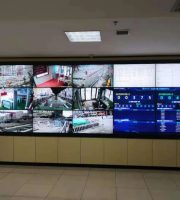2.3.4.4 During construction, the storage temperature of modified asphalt shall not exceed the temperature specified by the supplier.
1.3 The pavement scheme of steel bridge pavement roadway targeted in this instruction is “steel plate sand blasting+methyl methacrylate (MMA) waterproof bonding system+cast asphalt concrete GA10+high elasticity modified asphalt SMA10 (or SMA13)”.
2.
After it is confirmed to be qualified, it can be imported into the asphalt storage tank, and the modified asphalt shall be mixed or recycled according to the standard process during the construction of steel bridge deck pavement.
The performance index of methyl methacrylate (MMA) waterproof bonding layer material must meet the relevant requirements of JC/T2251-2014 Polymethyl methacrylate (PMMA) Waterproof Coating.
2.3.4.3 The mixing or recycling process of modified asphalt shall be carried out according to the requirements of the material supplier.
2.1.3 After materials arrive at the site, they shall be stored and managed according to the characteristics of materials and corresponding regulations.
Materials 2.1 General provisions 2.1.1 When purchasing materials, material specifications, quality, technical requirements, etc.
2.3.2 See Table 2.2 for the technical requirements of highly elastic modified asphalt for SMA10 (or SMA13), median separator and sidewalk pouring, and meet the grading standard of PG76-28.
1.2 This instruction specifies the technical requirements and inspection methods of raw materials for steel bridge deck pavement, the technical requirements and inspection methods of asphalt mixture, the methods and standards for rust removal and anti-corrosion of steel bridge deck, the requirements for pavement bonding and waterproofing, and the construction methods, quality management, inspection and acceptance methods and standards for asphalt concrete pavement.
2.3.4.2 The modified asphalt transported to the site shall be mixed evenly, and the performance test shall be carried out.
Focusing on the Methacrylic Resin (MMA) for Road (Bridge) Profession, Profession, and Re Profession 1.
General 1.1 This guide is prepared to implement the policy of “careful design, careful construction, and quality first”, ensure the quality of the cast-in-place asphalt concrete bridge deck pavement, and make the steel bridge deck pavement smooth, skid resistant, dense, and durable.
All materials shall be tested and inspected upon arrival and can only be used after passing the acceptance.
The pavement scheme of the central separator is “steel plate sand blasting+methyl methacrylate (MMA) waterproof bonding system+pouring asphalt concrete GA10+pouring asphalt concrete GA10”; The pavement scheme of sidewalk is “steel plate sand blasting+methyl methacrylate (MMA) waterproof bonding system+cast asphalt concrete GA10”.
2.1.2 The materials shall be attached with the ex factory quality inspection sheet upon arrival.
2.2 Waterproof bonding material, steel bridge deck, sand blasting and derusting, with cleanliness of Sa2.5 and roughness of 50-100 μ After m, spray anti methyl methacrylate (MMA) water bonding layer material.
1.3 The design and construction of steel bridge deck pavement shall not only comply with this Guide, but also comply with the current relevant standards and specifications issued by the state.
shall be proposed to the material supplier.
2.3.3 In order to ensure the quality of modified asphalt, qualified finished modified asphalt shall be used.
2.3 Asphalt binder 2.3.1 The performance and technical requirements of polymer modified asphalt used for roadway pouring asphalt concrete are shown in Table 2.1 and meet the PG82-22 grading standard.
Table 2.1 Technical Requirements for Road Cast Asphalt Concrete Modified Asphalt Test Items Index Requirements Test Method Penetration (25 ℃), 0.1mm20 ~ 60JTGE20-2011 T0604 Ductility (5 ℃), cm ≥ 20JTGE20-2011 T0605 Softening Point, ℃ ≥ 80JTGE20-2011 T0606 Elastic Recovery (25 ℃),% ≥ 90JTGE20-2011 T0662 Elastic Recovery (220 ~ 240 ℃, 200r/min mixing for 2h), (25 ℃),% ≥ 72 Flash Point (Cleveland Open Cup), ℃ ≥ 240JTGE20-2011 T0611 The aging quality change of rotary film oven is not greater than,% ± 0.5JTGE20-2011 T0610 penetration ratio (25 ℃),% ≥ 65 elastic recovery rate (25 ℃),% ≥ 80PG classification PG82-22AASHTO-TP1/TP5 Table 2.2 Technical requirements for surface layer SMA10 (or SMA13), central separation strip and access road castable pavement modified asphalt Test items Index requirements Test method penetration (25 ℃), 0.1mm50 ~ 100JTGE20-2011 T0604 softening point, ℃ ≥ 80JTGE20-2011 T0606 ductility (5 ℃), cm ≥ 70JTGE20-2011 T0605 viscosity (135 ℃) Pa • S ≤ 3JTGE20-2011 T0625 elastic recovery rate (25 ℃),% ≥ 90JTGE20-2011 T0662 flash point, ℃ ≥ 250JTGE20-2011 T0611 rotary film oven aging quality change, not more than% ± 0.5JTGE20-2011 T0610 penetration ratio (25 ℃),% ≥ 65 elastic recovery rate (25 ℃), %≥ 80 ductility (5 ℃), cm ≥ 40PG classification PG76-28AASHTO-TP1/TP5 2.3.4 Modified asphalt storage 2.3.4.1 Modified asphalt storage tank with thermal insulation and mixing or circulation function shall be available on site, and the storage capacity shall not be less than 30t.
2.3.4.5 The initial temperature, time, discharge temperature and other data of each asphalt mixing shall be recorded in detail..


